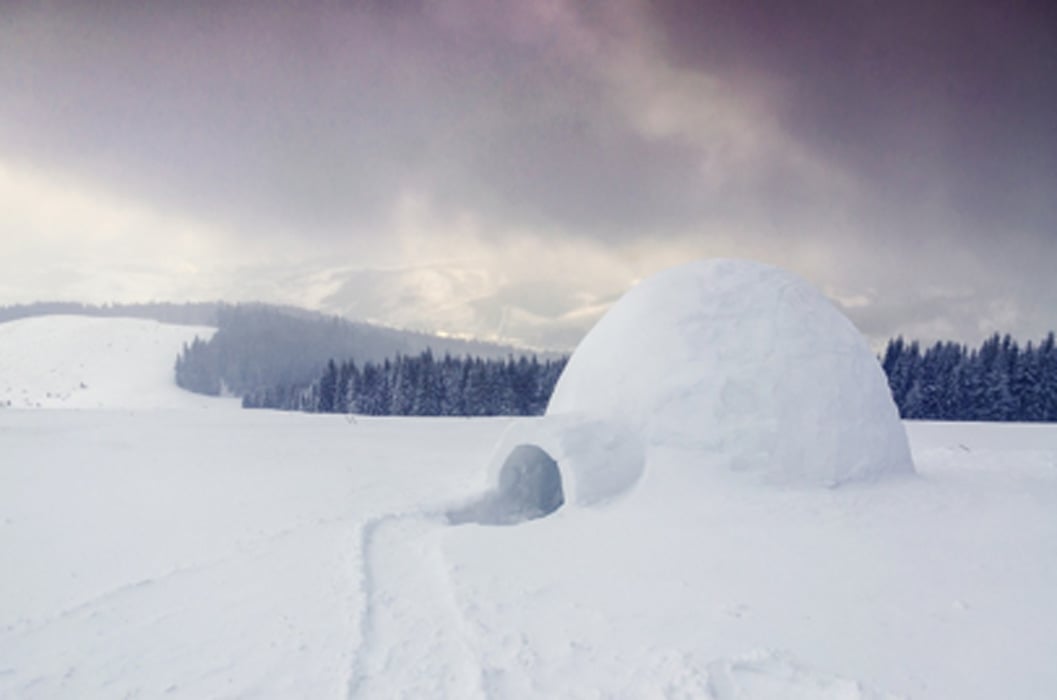Survival of the Inuit in a Harsh and Unforgiving World
The native people of the circumpolar region, the Inuit or Inupiat as they are called in the West, lived in sub-zero temperatures for much the year but survived and even thrived.
Their diet consisted chiefly of meat because no edible plants grow in the region where they live, a bit south of the North Pole. The game they hunted, whales, fish, seals and walruses, supplied not just their food, but many of the tools and implements they needed.
In the summer, they lived in tent-like structures made of bones and animal skins, says an article about the Inuit on the website Windows to the Universe. In the winter, of course, they built dome-like structures, made of blocks of snow, called igloos.
And they stayed warm enough to survive.
Genes & Technology Helped Inuit Survive
Part of the reason they could live in such a frigid region is because they were brilliant in their technology—the igloos that provided such good insulation, the kayaks that they fished from, the warm jackets and boots made of animal skins, and their hunting tools. If the Inuit needed to travel by water, they also had craft larger than kayaks called umiaks.
Another reason that might have helped them live well and prosper is because their genetic makeup includes an anomaly not known among other peoples. Some researchers, led by a team from the University of California at Berkeley, published a study (PDF file here) in the journal Molecular Biology and Evolution.
The researchers concluded that Inuit peoples have a genetic predisposition that others lack for producing more brown fat cells than white fat cells. Brown fat cells burn energy and produce heat, whereas white fat cells just store calories.

Eskimo village from snow huts (Juulijs / Fotolia)
Life Changed, but Inuit Culture Lives On
Windows to the Universe says: Although Inuit life has changed significantly over the past century, many traditions continue. Traditional storytelling, mythology, and dancing remain important parts of the culture. Family and community are very important. The Inuktitut language is still spoken in many areas of the Arctic and is common on radio and in television programming.
The changes came in the 1960s when various governments required the Inuit to settle down in villages and not have winter and summer hunting camps. Prior to this, they had lived in different places depending on seasonal hunting patterns and game migrations. They still hunt today.
In the 1940s, the Inuit came more in contact with European people than they ever had before. They had been mostly ignored and allowed to live as they chose. Their home, the sub-Arctic region, was considered a wasteland.
The Western powers became more interested in the region for reasons of security. Governments built airports and radar bases. Airplanes made the world smaller, too, or at least seemed to, and the Arctic seemed less remote.

Traditional Inuit seal hunter (Erica Guilane-Nachez / Fotolia)
Learning Western Culture
In the villages, the Inuit learned Western culture. Government agencies built clinics and schools, and “in many places, Inuit children were required to attend schools that emphasized non-native traditions.”
The Inuit population grew so much that their traditional hunting could not support the larger population. Some hold-outs lived in camps, but they soon moved into the villages because they could get jobs and food was plentiful.
Inuit Gods and Goddesses
A few of the more prominent Inuit gods and goddesses include:
- The moon god Annigan is famous among the Greenland people for chasing his sister, Malina the sun goddess. Annigan the moon forgets to eat, so he gets thinner and finally is just a tiny crescent. Annigan and Malina originally had been together but then parted after a terrible fight and became the sun and moon alternating daily and nightly in the skies.
- Sedna the sea spirit has a particularly sad story. She refused to marry, so her father forced her to marry a dog. Then the father felt bad, so he drowned the dog, rendering Senda incapable of caring for their children. She sent her children to live with others. Sedna then agreed to marry a bird in the form of a man. She soon discovered he was a bird, not a man. When her father visited, the two of them left in a boat. The bird came after them and made a huge storm with his wings. Sedna’s father threw her overboard. She clung to the side, but he chopped off her fingers, which became the seals and other sea animals. Now she lives under the sea with the animals created from her fingers.
The online Canadian Encyclopedia says the Inuit of Canada’s Arctic region are part of a family of people who live along the Bering Sea, across Alaska and Canada to Greenland.
“These imaginative, hardy and resourceful peoples are linked not only linguistically, but by a distinctly similar culture and way of life, as seen through Inuit art, song, dance, myth and legend,” the encyclopedia states.
The encyclopedia page linked to here includes a more complete pantheon and some of the strange stories of the supernatural Inuit beings.
The book Mythology of the American Nations say the Inuit tribes are descended from people who left Siberia about 5,000 years ago.
Nunavut: Inuit territory

(Wikimedia Commons map)
In 1999, the Canadian government created the Nunavut territory that is controlled by the Inuit people. A glance at the accompanying map shows how huge the territory is.
Top image: An igloo or house of made of snow for winter dwelling (Volodymyr Shevchuk / Fotolia)



















